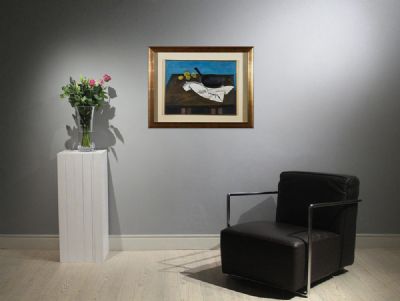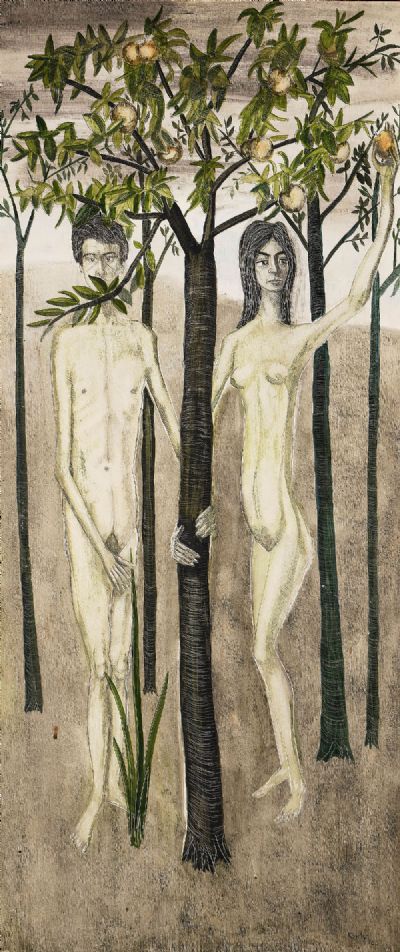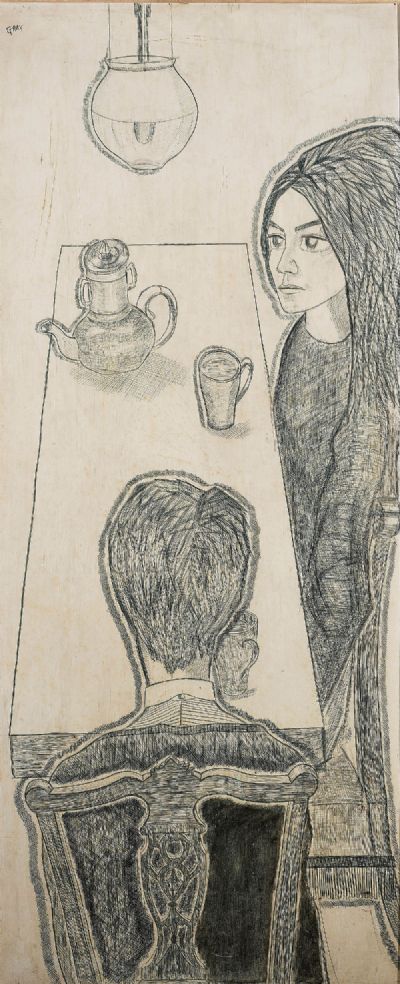Bidding on this item has ended.
William Scott
STILL LIFE WITH FRYING PAN (1946)
Lot 19
Price Realised:
€200,000
Estimate:
€200,000 - €300,000
William Scott CBE RA, 1913-1989
STILL LIFE WITH FRYING PAN (1946)
Oil on canvas, 18" x 24" (46 x 61cm), signed and dated 1946.
Provenance: Roland, Browse and Delbanco, London; Piccadilly Gallery, London; Sotheby's, London, 14 December 1966, lo... Read more
 Lot 19
William Scott
STILL LIFE WITH FRYING PAN (1946)
Lot 19
William Scott
STILL LIFE WITH FRYING PAN (1946)
STILL LIFE WITH FRYING PAN (1946)
Oil on canvas, 18" x 24" (46 x 61cm), signed and dated 1946.
Provenance: Roland, Browse and Delbanco, London; Piccadilly Gallery, London; Sotheby's, London, 14 December 1966, lo... Read more
 Lot 19
William Scott
STILL LIFE WITH FRYING PAN (1946)
Lot 19
William Scott
STILL LIFE WITH FRYING PAN (1946)
Estimate:
€200,000 - €300,000
William Scott CBE RA, 1913-1989
STILL LIFE WITH FRYING PAN (1946)
Oil on canvas, 18" x 24" (46 x 61cm), signed and dated 1946.
Provenance: Roland, Browse and Delbanco, London; Piccadilly Gallery, London; Sotheby's, London, 14 December 1966, lot 121a; Wilmott Paul Gell; Private collection; Christie's, London, 30 May 1997, lot 52 (as Still life with Frying Pan and Toasting Fork); Private collection Sotheby's, London, 13 May 2005, lot 148 (as Still Life with Frying Pan).
Exhibited: Roland, Browse and Delbanco, London, Currents of Post Impressionism in France and England, July 1946, no. 20.
Literature: This work is No.103 in The William Scott Catalogue Raisonee who state:
"It is one of the earliest still-life compositions to include a frying pan, the object that above all others reminded Scott of his childhood in Enniskillen. Whether it was painted before or after The Frying Pan (cat. no. 102) is not known: it may be the case that Scott worked on the two paintings around the same time. Here, the smooth round shape of the pan is contrasted with the sharp-edged folds of the white cloth (reminiscent of the creases in the greaseproof paper used by the local fishmongers to wrap fish [see Mackerel with Plate and Paper, cat. no. 95, and Still Life, Fish, cat. no. 96]) and the prongs of the fork."
William Scott was born in Scotland, but his Donegal-born father moved the family to Enniskillen, Northern Ireland, in 1924. He showed interest in art from a young age and eventually made his way to London when in 1931 he gained a place at the Royal Academy Schools. Over the following decades his reputation has grown steadily, becoming one of the most sought-after artists of his generation—not only in Ireland and the UK, but worldwide. The list of major public collections from every continent who have acquired Scott's work is impressive, including the Museum of Modern Art (NY), the Guggenheim (NY), the Metropolitan Museum (NY), the Hirshhorn (Washington DC), the Tate Gallery (London), the V&A (London) and, closer to home, the National Gallery of Ireland, the Irish Museum of Modern Art, the Crawford Gallery and the Hugh Lane.
Scott is most commonly identified with still life paintings. Though many of his later works are highly abstracted, their roots are often in objects from a simple Irish country kitchen: pots, frying pans, toasting forks, knives and the like. These simple unpretentious objects reflect a distinct Northern Irish austerity. Even when the influence of American Abstract Expressionism on his paintings became stronger, Scott was constantly drawn back to more European-based figuration, with hints of his still life repertoire finding their way into the most abstract pictures.
Throughout his career we have this push and pull between representation and abstraction, and this is evident even in this seemingly 'realistic' Still Life from 1946. It is a striking example of early Scott, showing how an abstract way of thinking underpins all his work. On one level it's an image reflecting the austerity and rugged, unpretentious honesty of rural domestic life. On another level, it's an elegant, sophisticated arrangement of abstract forms where the artist has organised shapes to maximise visual tension. The table is a solid block that anchors the composition, but Scott's use of diagonals set the picture in motion. Everything is carefully placed, huddled around a central point while simultaneously drawing eyes away from it, like the corners of the cloth and the fruit. However, the main event is the visual dialogue between the handle of the skillet and the counter-movement of the fork handle. All this, so subtle that it's hardly noticed, gives the painting a certain frisson, a satisfying energy. These are the elements of a quintessential Scott.
Dr Frances Ruane RHA
STILL LIFE WITH FRYING PAN (1946)
Oil on canvas, 18" x 24" (46 x 61cm), signed and dated 1946.
Provenance: Roland, Browse and Delbanco, London; Piccadilly Gallery, London; Sotheby's, London, 14 December 1966, lot 121a; Wilmott Paul Gell; Private collection; Christie's, London, 30 May 1997, lot 52 (as Still life with Frying Pan and Toasting Fork); Private collection Sotheby's, London, 13 May 2005, lot 148 (as Still Life with Frying Pan).
Exhibited: Roland, Browse and Delbanco, London, Currents of Post Impressionism in France and England, July 1946, no. 20.
Literature: This work is No.103 in The William Scott Catalogue Raisonee who state:
"It is one of the earliest still-life compositions to include a frying pan, the object that above all others reminded Scott of his childhood in Enniskillen. Whether it was painted before or after The Frying Pan (cat. no. 102) is not known: it may be the case that Scott worked on the two paintings around the same time. Here, the smooth round shape of the pan is contrasted with the sharp-edged folds of the white cloth (reminiscent of the creases in the greaseproof paper used by the local fishmongers to wrap fish [see Mackerel with Plate and Paper, cat. no. 95, and Still Life, Fish, cat. no. 96]) and the prongs of the fork."
William Scott was born in Scotland, but his Donegal-born father moved the family to Enniskillen, Northern Ireland, in 1924. He showed interest in art from a young age and eventually made his way to London when in 1931 he gained a place at the Royal Academy Schools. Over the following decades his reputation has grown steadily, becoming one of the most sought-after artists of his generation—not only in Ireland and the UK, but worldwide. The list of major public collections from every continent who have acquired Scott's work is impressive, including the Museum of Modern Art (NY), the Guggenheim (NY), the Metropolitan Museum (NY), the Hirshhorn (Washington DC), the Tate Gallery (London), the V&A (London) and, closer to home, the National Gallery of Ireland, the Irish Museum of Modern Art, the Crawford Gallery and the Hugh Lane.
Scott is most commonly identified with still life paintings. Though many of his later works are highly abstracted, their roots are often in objects from a simple Irish country kitchen: pots, frying pans, toasting forks, knives and the like. These simple unpretentious objects reflect a distinct Northern Irish austerity. Even when the influence of American Abstract Expressionism on his paintings became stronger, Scott was constantly drawn back to more European-based figuration, with hints of his still life repertoire finding their way into the most abstract pictures.
Throughout his career we have this push and pull between representation and abstraction, and this is evident even in this seemingly 'realistic' Still Life from 1946. It is a striking example of early Scott, showing how an abstract way of thinking underpins all his work. On one level it's an image reflecting the austerity and rugged, unpretentious honesty of rural domestic life. On another level, it's an elegant, sophisticated arrangement of abstract forms where the artist has organised shapes to maximise visual tension. The table is a solid block that anchors the composition, but Scott's use of diagonals set the picture in motion. Everything is carefully placed, huddled around a central point while simultaneously drawing eyes away from it, like the corners of the cloth and the fruit. However, the main event is the visual dialogue between the handle of the skillet and the counter-movement of the fork handle. All this, so subtle that it's hardly noticed, gives the painting a certain frisson, a satisfying energy. These are the elements of a quintessential Scott.
Dr Frances Ruane RHA
- Enquire
- View all lots by this artist
- How bidding works
Please note: You will require a deVeres account in order to bid. Please register via the website. Each lot will close numerically. If there is late bidding the time may be extended which could delay subsequent lots. The lots will start to close from 2.00pm on auction day, closing at 45 second intervals.
PLEASE BID EARLY TO AVOID DISAPPOINTMENT.
In order to allow rival bidders the opportunity to respond to a late bid the following extensions will apply:
IF A BID IS RECEIVED WITHIN THE FINAL 45 SECONDS OF THE COUNTDOWN THE CLOCK WILL RESET TO 60 SECONDS.
At any point you can leave a maximum bid, representing the highest price you are prepared to pay for a particular lot. Bidding only advances when there is competition from a rival bidder. In that case the system bids on your behalf, only up to the maximum if required. All bids are relayed to you be email, along with notification if you have been outbid.
All maximum bids are confidential and not disclosed. The system will endeavor to purchase the lot for you for the least price. Bids are subject to buyer’s premium of 25% (incl vat), with no additional charges.
In the event of a tied bid, the preference will be given to the bid submitted first. The second bidder will receive immediate notification of being outbid.
PLEASE BID EARLY TO AVOID DISAPPOINTMENT.
In order to allow rival bidders the opportunity to respond to a late bid the following extensions will apply:
IF A BID IS RECEIVED WITHIN THE FINAL 45 SECONDS OF THE COUNTDOWN THE CLOCK WILL RESET TO 60 SECONDS.
At any point you can leave a maximum bid, representing the highest price you are prepared to pay for a particular lot. Bidding only advances when there is competition from a rival bidder. In that case the system bids on your behalf, only up to the maximum if required. All bids are relayed to you be email, along with notification if you have been outbid.
All maximum bids are confidential and not disclosed. The system will endeavor to purchase the lot for you for the least price. Bids are subject to buyer’s premium of 25% (incl vat), with no additional charges.
In the event of a tied bid, the preference will be given to the bid submitted first. The second bidder will receive immediate notification of being outbid.
Sign-up to our auction alert
Signup for personalised Irish art recommendations, invitations to viewings and auctions, articles and more.





 View More Videos
View More Videos DVTV Click Here To View Video
DVTV Click Here To View Video


